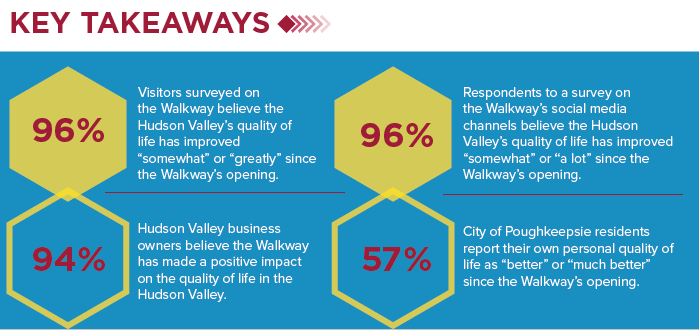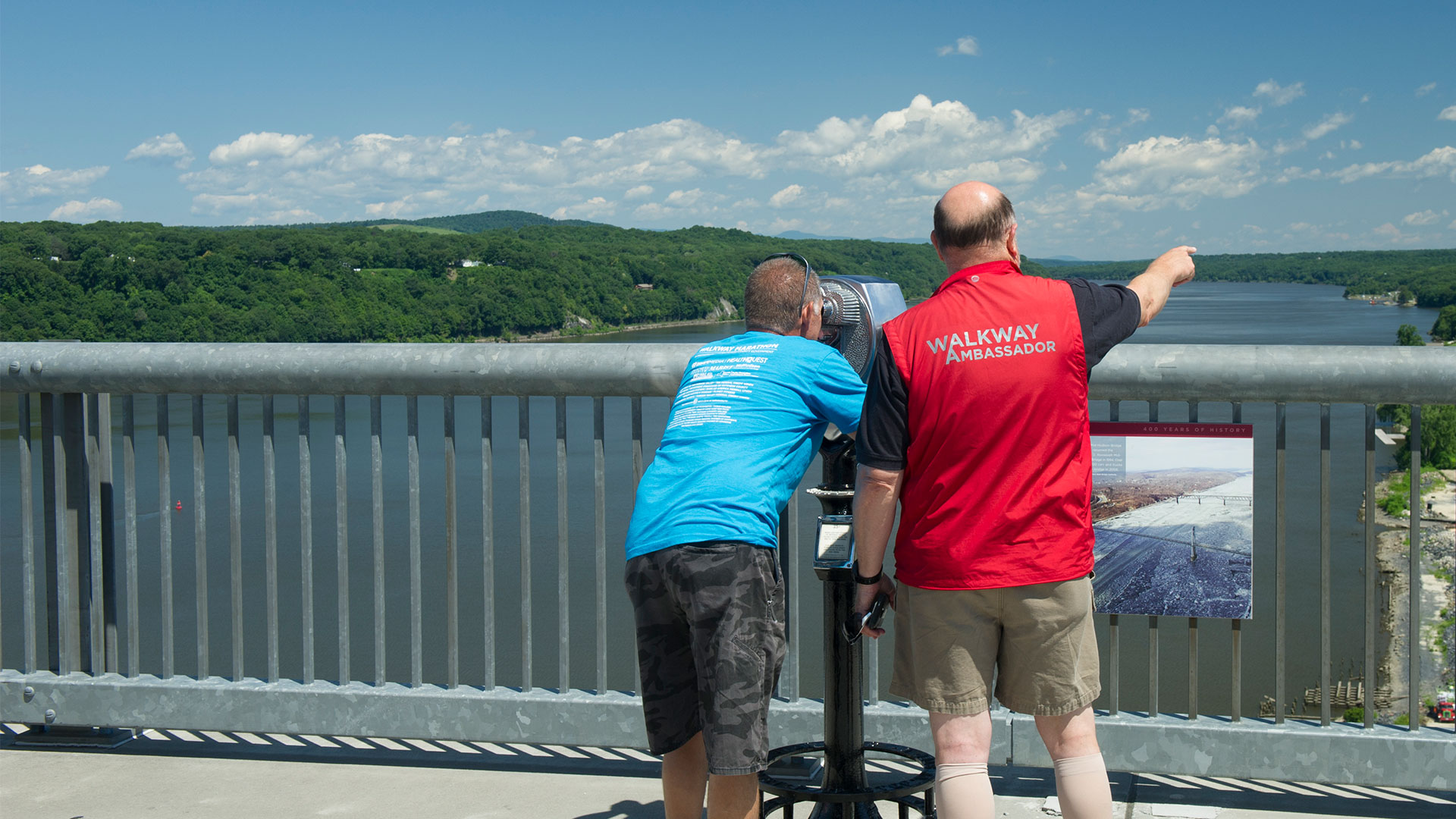
In its first decade of existence, Walkway Over the Hudson State Historic Park has significantly improved local residents’ quality of life, brought new customers to area businesses, and bolstered the nonprofit community, report shows.
>>Download Complete Quality of Life Study

According to a comprehensive study completed by Newburgh-based Pattern for Progress, with support from Marist College, 96 percent of respondents in two separate surveys believe the Walkway Over the Hudson State Historic Park has somewhat or greatly improved the quality of life for residents of the Hudson Valley.
The research found that 88 percent of nonprofit organizations that hosted fundraisers on the Walkway and disclosed fundraising numbers generated more donations than previous, similar events not held on the bridge. Walkway data indicates that all nonprofit events on the landmark structure since 2009 have resulted in over $8 million raised for local causes.
Additionally, Pattern’s research shows 57 percent of residents of the City of Poughkeepsie believe the Walkway has improved their own personal quality of life. In the business community, 94 percent of business owners said the Walkway has improved the area’s quality of life, and 41 percent of City of Poughkeepsie businesses (sampled across all eight wards) report increased revenue since the opening of the Walkway.
The study confirmed Walkway visitors are also spending money in the local community, with over 57 percent of first-time and 65 percent of returning visitors intending to visit a City of Poughkeepsie restaurant; 36 percent of first-time and 44 percent of returning visitors intending to patronize a local retail business; and over 31 percent of all Walkway users planning to visit other tourist destinations in the area.
The Study Concludes
The beauty and accessibility of the Walkway Over the Hudson has had widespread positive impacts on the Quality of Life of residents and tourists, as well as beneficial impacts to local businesses and other tourist attractions. The introduction of public parks in urban areas has been correlated with a decrease in mental and physical health issues, which are widespread in impoverished areas, through an increase in social interaction and an increase in exposure to nature, showing that “a community’s quality of life is directly tied to both the quantity and quality of parks and green spaces.”
The impacts of the Walkway Over the Hudson range from restoring a sense of pride in the community, providing health and fitness benefits, serving as a place to celebrate a milestone or show solidarity for a cause, and generally being an accessible place to enjoy the beauty and tranquility of the Hudson River.
Walkway Demographics
The self-reported demographics found in the Quality of Life Report provides a snapshot of who uses the Walkway, how they use it, and how often they use it.
Residents of Dutchess or Ulster Counties comprise 52 percent of visitors to the Walkway. 64 percent are female. The typical Walkway user is between the ages of 46-65 (49.5 percent) with 27 percent of users between the ages of 21-45. 15 percent are over 65, and five percent are under 21.
Most Walkway users visit with one other person (46 percent), while 25 percent are in a group of 3-4, and 18 percent with five or more people. 12 percent of Walkway users come to the park alone.
First-time Walkway visitors reported overwhelmingly visiting to enjoy the view (59 percent), with 40 percent saying they were a tourist, 33 percent coming for fitness/exercise, and 28 percent for entertainment. Among repeat Walkway visitors, 72 percent report primarily utilizing the bridge for exercise, with 69 percent citing to enjoy the view.
Among the 54 percent of visitors that have made multiple visits to the Walkway, 42 percent are frequent users who have been to the bridge more than 20 times.
Walkway Stories
The data contained in the Quality of Life Report comes alive via the personal stories researchers collected during their study, like that of a despondent 66-year old Poughkeepsie woman who once ventured on the Walkway while considering to end her life. But, as she told researchers, when she made it to center of the Walkway and took in the beauty of her surroundings, she had a moment of profound clarity, felt “closer to God,” and regained the will to live thanks in part to the serenity of her surroundings.
A City of Poughkeepsie man told researchers about his friend who was severely overweight when the Walkway opened in 2009. Inspired by the unique setting, the friend would exercise on the bridge every day, resulting in a significant weight loss that changed his life and his health for the better.
Other common refrains about how the Walkway has positively impacted residents include helping people spend more time with their family, overcoming a fear of heights, and providing easy, car-free access to the other side of the river.
About The Study
The analysis in the Quality of Life report draws primarily on first-hand research conducted by four teams using different methods and tools. In all, 830 points of data were collected.
The first of these teams and tools was a survey designed by Pattern for Progress and administered by the Walkway organization both in-person and online.
The second team was a class of Marist College students in the School of Management, who created a survey under the direction of Pattern for Progress and administered it to City of Poughkeepsie residents as well as provided direct research.
The third research team was one of three Pattern Fellows research groups that compiled secondary data as well as devised their own survey that they administered to residents in the Hamlet of Highland. Pattern Fellows are local leaders who join together in an innovative leadership program helping participants gain a more intimate understanding of the Hudson Valley and explore regional approaches to solving complex problems.
The fourth team was the Pattern research team themselves, who conducted stakeholder surveys with various community leaders, and completed direct research with other parties with vested interests in the Walkway.
Data was also acquired and analyzed from secondary sources such as the U.S. Census Bureau’s decennial census and annual American Community Survey, and two previous economic impact studies conducted by Camoin & Associates, and focus groups conducted by VOX, on behalf of the Walkway organization.
Other insights, anecdotes, and examples have been drawn from the experience of the authors of the report, who have spent collective decades as participant-observers and residents of the Hudson Valley region.







